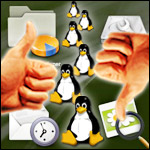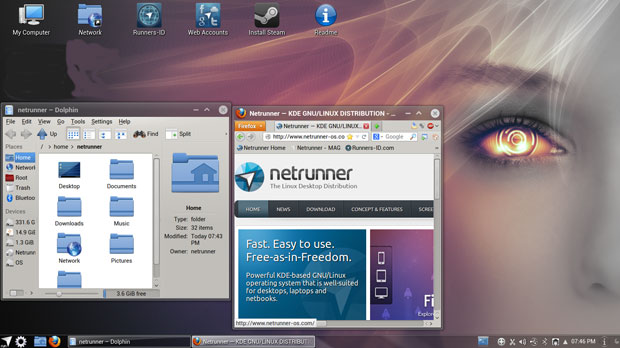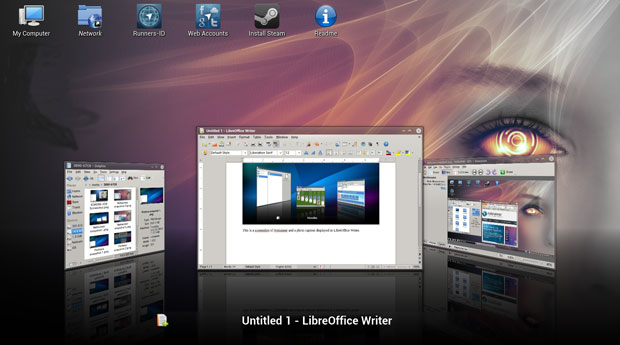
![]()
“Enigma” may be the nickname of the latest release of the Netrunner Linux distro, but there’s actually nothing enigmatic about it.
In fact, Netrunner 13.06 — also known as “Netrunner 5” — delivers one of the most satisfying out-of-the-box desktop experiences I have had in quite some time.I spend an inordinate amount of time testing and using different Linux distributions. My experiences with these sometimes-obscure distros and other Linux applications are the subjects right here in this weekly Linux Picks and Pans report.
After putting so many Linux distros through their paces, though, one desktop flavor tends to blur with another. Most distros, regardless of their desktop options, are very similar; more often than not, their distinguishing trait is how they perform or what they lack or how they differ from the expected.

Some distros have their own unique quirks that take getting used to. Others need the next release before they can become a more comfortable fit.
Yet Netrunner 5 “Enigma,” which was released last month, does what many distro retreads fail to do: It achieves a distinctive quality that makes it stand apart from other distros. Specifically, that secret sauce for Netrunner is a solid effort at integrating classic KDE desktop performance with Web-based applications and cloud services.
A Distinctive Look and Feel
Think Kubuntu — as in the KDE version of Ubuntu — with a splash of Linux Mint and a dash of GNOME integration. This combination makes Netrunner very compatible with Ubuntu applications in particular and all things Debian in general.
The Netrunner distro focuses on just one desktop shell. It smoothes out that user interface. Then it blends in refinements not found elsewhere.
The GNOME-style bottom panel holds the applications menu at the left end along with launcher icons for the Dolphin file manager and the default Firefox Web browser. A system tray of sorts is on the right end holding icons for Internet and device connections as well as the virtual workspace pager widget.
A right-click on any main menu item lets you place an icon for that application on the desktop and/or favorites menu. Plus, you have full control over panel settings and additional widgets you might want to place there.
Best of Two Worlds
If you are not a fan of the KDE desktop environment, give Netrunner a try anyway. The Netrunner version may well change your mind. It is clean and simple to use.
Other Linux distros try similar approaches, but Netrunner’s developers execute their design better than the others. The KDE desktop can be a bit daunting to work through, with all of its myriad options and configuration settings. Not so with the KDE integration built into Netrunner, however.
One of the design features that simplifies the desktop interface is the built-in clean folderview desktop screen. So in this KDE iteration, there is no Activities hot-corner in the upper right of the screen to fuss with. Instead, a search-style interface with some of that functionality pops up on the screen if you click its icon in the bottom panel.
Under the Hood
Netrunner comes in 64- and 32-bit versions. This latest release has KDE version 4.10.4 with Linux kernel 3.8.0 and Dolphin 2.2 as the file manager. Flash and MP3 codecs are included with the installation.
Window themes are the domain of the new KWin Aurorae 3 Engine. This seems to give good results on even my older gear and aging netbook. Mint Software Sources and Hardware Manager tools are included for added compatibility.
I am often disappointed with the installed base of applications in most distributions, but Netrunner’s software arsenal let me get real work done without having to first install applications I want to use.
For example, included with the installed set of software is Firefox for KDE. Its support package allows for native file dialog and mimetype extension for the KDE Workspace.
More App Adoration
LibreOffice and some of the Calligra suite components provide the mainstay of the office applications. Kate — KDE’s powerful text editor — is also included.

Other worthwhile packages are FileZilla, an FTP client; GIMP for image editing; the VLC media player; the Tomahawk music librarian; the Kamoso image retriever; the WinFF video converter; VirtualBox; and Skype. Yakuake is Netrunner’s Qt-native drop-down terminal.
Muon, meanwhile, handles the package manager chores. It does system updates and has its own App Store called Muon Discover. The Synaptic Package manager is also preinstalled. Pleasantly, the Steam client is available for easy installation.
Also worth noting is that the Netrunner project just recently released Netrunner SE 13.06, where the “SE” stands for “stealth edition.” Designed for extra privacy and security, this release includes Firefox preconfigured with Tor, FoxyProxy, HTTPs Everywhere and NoScript, as well as Thunderbird with Enigmail, among other anonymity-minded tools.
Beyond Local
One of the best features is Netrunner’s clever integration with Web applications. I was impressed with the fluidity and ease of access to those apps.
A separate category for this feature is on the applications menu. You can access Dropbox, Facebook, Twitter and YouTube from this menu. You can also click on a link to your Runners-ID account. Runners-ID is a free cloud storage service that provides a digital closet for your data, contacts, calendar events, photos and music streaming. You get 2 GB of free space per account.
An icon for this service is on the desktop as well. Clicking on an entry takes you to a preloaded page in the Web browser.
Similarly, the Web Apps menu has links to a variety of Google Web services. These include Google Docs, Google Mail, Google Calendar, Google Contacts and Google Maps. Several Web-based games are listed in this Web App category’s menu as well.
In addition, Netrunner has its own Game category in the menu. It offers about 14 different titles in five subdivisions. You get more preinstalled gaming options in Netrunner than I have seen in most other Linux distros.
Bottom Line
Netrunner has many extras not found in other Linux distros. Its embellished KDE interface is clean and easy to use. Yet the distro itself, while attractive to Linux newcomers, has much to entice Linux veterans as well.
Netrunner is clearly a step or two ahead of typical Linux distros. It is a solid performer that is well-supported by the community forums. It could be one of the best KDE variations in the Linux desktop market.
Want to Suggest a Linux Application for Review?
Is there a Linux software application you’d like to suggest for review? Something you love or would like to get to know?
Please send your ideas to me at [email protected], and I’ll consider them for a future Linux Picks and Pans column.
And use the Talkback feature below to add your comments!





















































Correct, Netrunner is awesome, especially for new Users. There new rolling branch is also very fine and there are just 2 Distros, who can reach this Level for me: PCLinuxOS and KaOS, maybe PC-BSD.
So they bundle links to pay services both common (Dropbox) and obscure/proprietary ("Runners-ID"?) and that’s supposed to be a GOOD thing?
Ugh. Seems more like a bug than a feature. If I wanted crapware and trialware and proprietary branded services bundled with an OS I’d stick to Dell Windows machines or Ubuntu.
Thanks for the article; it’s good to know there’s a non-Canonical distribution that still uses KDE and Debian, but still I think I will end up with Mageia. They still make it possible to have a fully ‘free’ version, while still offering the non-free components if desired. It looks as if NetRunner isn’t even making that effort.
(I’m not inclined to go purely free, but it’s good that it’s available.)
But maybe I’m wrong. I think I’ll be trialing both — thanks for the review, Jack!
JohnJark, can you describe NetRunner’s userbase and viability? (I think those should be a big part of LinuxInsider’s reviews.)
I’m also trying to find a good KDE distribution, and despite research I hadn’t even heard of NetRunner until this review. The closest I found was SolydXK, which worries me because I don’t think it has a very large development community or user base behind it.
Mageia, on the other hand, seems like a much better supported platform. It’s Mandriva, but I’d prefer to stick with a Debian variant, so NetRunner does pique my interest.
Is there a good community and support options?
Hi blinux,
Can I offer my thoughts on your observations of ‘commercial’ options?
Yes – there are ‘commercial’ options in NetRunner. But Linux has been criticised in the past for being commercially blind to ‘paid’ options. I think this is limiting – take advantage of the ‘paid’ options if you wish (who doesn’t use cloud, and social these days?) but encourage Linux to sit above this with free and open source and sensible commercial options integrated.
This gives greater freedoms to us all.
I would also qualify the NetRunner offering in that it also gives you free cloud Runners-ID. So NetRunner stands above and is inclusive – a nice totality I think.
Attractions for me to move to NetRunner included:-
– it is Debian/Ubuntu based so capitalised on my experience + the user/dev base of both.
– it has Blue Systems behind it which is a key contributor to KDE with the commensurate dev expertise.(BTW – Blue Systems provides KDE to Ubuntu)
– my early experience of using the support community was first rate – relevant answers quickly – but just a small sample I hasten to add.
I tried Mageia also, but the installation process was not good – trashed a partition for me – so a bit averse here.
Nice article Jack.
But an update. Netrunner now runs on KDE 4.11 – probably the first distro to get this out to the users.
Just a delight to use – I agree completely with you.
We moved to NetRunner from Kubuntu some months ago. Canonical has moved itself from asset to liability – Gnome, Mir, Unity without much sharing.
We love KDE and spent a lot of time looking for a distro where KDE is cared for, and likely to survive past Mir.
NetRunner does this + gives a wonderful desktop to boot.
Never mind trying out KDE on NetRunner – just move to NetRunner and enjoy the total experience.